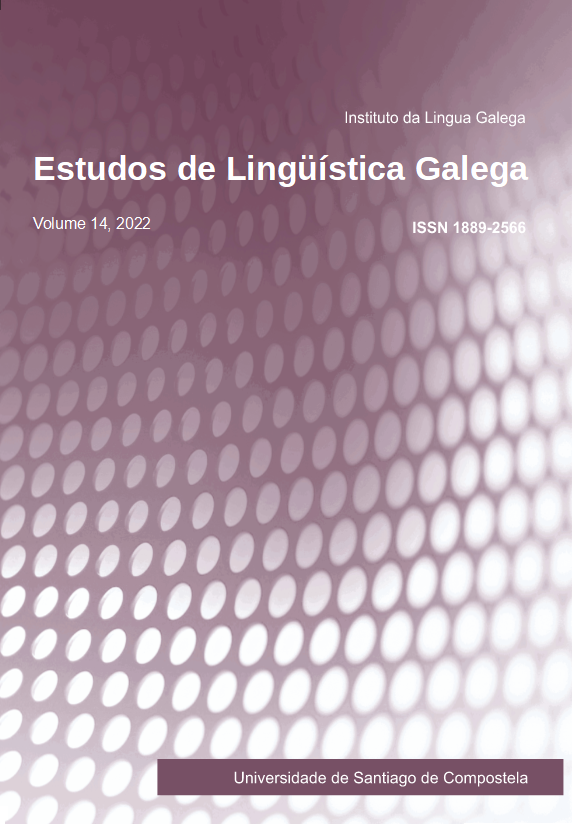Eu às vezes digo com as letras e outras vezes digo sem as letras, porque eu sei escrever. Evolution of Portuguese dialectal features in 20th century
Main Article Content
Abstract
This paper analyses the changes in geographical distribution and frequency of use undergone in the second half of the twentieth century by the five linguistic features used by Lindley Cintra to establish his Nova proposta de classificação dos dialectos portugueses: 1. Absence/ presence of phonological opposition between /b/ and /v/. 2. Apical / laminal production of alveolar fricative phoneme. 3. Maintenance/ reduction of voiceless post-alveolar affricate phoneme [tʃ]. 4. Maintenance / reduction of diphthong ou, pronounced as [ou̯] or [au̯]. 5. Maintenance/ reduction of diphthong ei, mostly pronounced as [ei̯] or [ɐi̯]. The quantitative analysis was based on the information provided by a very large corpus made up of more than 100.000 answers that were contained in the unpublished questionnaires of the two big linguistic atlases that have described Portugal: the ill-fated Atlas Lingüístico de la Península Ibérica (ALPI), which explored Portuguese territory in 1936 and 1953-1954, and the Atlas Lingüístico-Etnográfico de Portugal e da Galiza (ALEPG), also executed in two separate intervals: 1973-1984 and 1988-1997. The refined description of each phenomenon at each point in time, based on the quantitative (and contrastive) examination of these two sources, is much more informative regarding their vitality than the picture provided by classical dialectology. Overall, it becomes clear that there has been a sharp decline of dialectal features during recent decades, especially the affricate phoneme, which is perceived negatively within the linguistic community. Finally, it is seen that traditional dialectal classifications, still widely used today, do not always describe real linguistic situations.
Keywords:
Article Details
References
Boléo, Manuel de Paiva (1951): “Dialectologia e história da língua. Isoglossas portuguesas”, Boletim de Filologia 12, 1–44 [republicado en Estudos de linguística portuguesa e románica, vol. I. Coimbra: Universidade de Coimbra, 1974, 185-250]
Cintra, Luís F. Lindley (1964-1971): “Nova proposta de classificação dos dialectos galego-portugueses”, Boletim de filologia 23, 81-116.
Martins, Ana Maria / Luísa Segura / Amália Andrade (2003): “Fragmentos: De uma reflexão sobre o conhecimento à manipulação dramática da prosódia”, en R. Caprini (ed.), Parole romanze. Scritti per Michel Contini. Alessandria: Edizioni dell’Orso, 243-258.
Pedrazuela Fuentes, Mario (2005): “Nuevos documentos para la historia del ‘ALPI’”, Revista de filología española LXXXV(2), 271-293.
Ricós Vidal, Amparo (2007): “España, Portugal y el ‘ALPI’. Notas para una historia inacabada“, en Ángel Marcos de Dios (ed.), Aula Ibérica: Actas de los congresos de Évora y Salamanca (2006-2007). Salamanca: Universidad de Salamanca, 183-194.
Saramago, J. (2006): “O Atlas Lingüístico-Etnográfico de Portugal e da Galiza (ALEPG)”, Estudis romànics XXVIII, 281-298.
Most read articles by the same author(s)
- Xosé Afonso Álvarez Pérez, Benavente Jareño, Pedro / Xesús Ferro Ruibal (2010): O libro da vaca. Monografía etnolingüística do gando vacún. Santiago de Compostela: Centro Ramón Piñeiro para a Investigación en Humanidades, Xunta de Galicia, 1637 pp. + CD-ROM , Estudos de Lingüística Galega: Vol 4 (2012)






